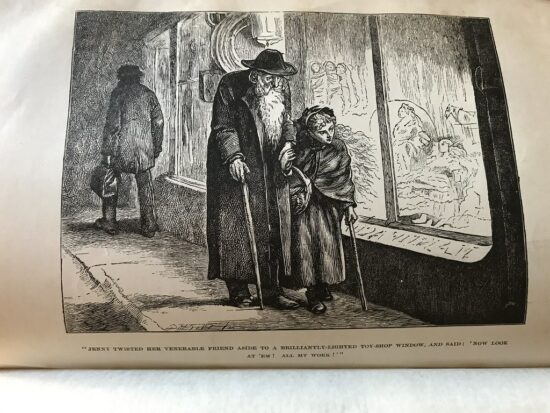Plot and Storyline
Little Dorrit is a novel written by Charles Dickens and was first published in 1857. Set in the early 19th century, the story revolves around the life of the titular character, Amy Dorrit, and her family’s struggles with poverty and social status in Victorian England.
The novel follows the life of Amy, also known as Little Dorrit, who grows up in the Marshalsea debtor’s prison where her father, William Dorrit, is incarcerated. The Dorrit family has lived in the prison for many years, and Amy becomes accustomed to the confined and impoverished lifestyle.
As the story progresses, Amy’s fortunes change when her father unexpectedly inherits a fortune and is released from prison. The Dorrits move to London and enter high society, where they encounter a cast of colorful characters, including the Merdle family, the Clennams, and the Meagles.
Amy finds employment as a seamstress for Mrs. Clennam, a stern and secretive woman who holds the key to a long-held family secret. Through her interactions with the Clennam family, Amy becomes entangled in a web of intrigue, deceit, and hidden identities.
The novel takes several twists and turns, revealing the true nature of characters and their motivations. Secrets are unveiled, and the characters grapple with the consequences of their actions. The story explores themes of love, loyalty, social class, and the corrupting influence of wealth.
Characters
Little Dorrit features a rich ensemble of characters, each with their own distinct personalities and storylines. Amy Dorrit, the protagonist, is a kind-hearted and selfless young woman who acts as the moral compass of the novel. Her unwavering love for her family and her resilience in the face of adversity make her a compelling character.
Arthur Clennam, another central character, is a kind and honorable man who becomes enamored with Amy. His quest for truth and redemption drives the narrative forward. Other notable characters include Mr. Dorrit, whose transformation from a humble prisoner to a self-important gentleman illustrates the corrupting influence of wealth, and the enigmatic and manipulative Mrs. Clennam.
Themes and Symbols
One of the major themes in Little Dorrit is the exploration of social class and its impact on individuals. Dickens portrays the stark contrast between the wealthy aristocracy and the impoverished lower classes, highlighting the injustices and inequalities of Victorian society. The novel also examines the corrupting influence of wealth and the moral decay that can accompany it.
Another theme is the power of love and compassion to transcend social barriers. Amy’s selflessness and unwavering love for her family and others ultimately triumph over the superficiality and greed of high society. The novel also explores the consequences of secrets and the importance of truth and redemption.
Symbols play a significant role in the novel, such as the Marshalsea prison, which represents the confinement and limitations imposed by social class. The Circumlocution Office, a bureaucratic institution that symbolizes inefficiency and corruption, satirizes the shortcomings of the government and bureaucracy of the time.
Writing Style
Charles Dickens is known for his vivid and descriptive writing style, and Little Dorrit is no exception. His prose is rich with imagery, humor, and social commentary. Dickens employs a wide range of literary techniques, such as foreshadowing, irony, and satire, to engage the reader and convey his messages.
The narrative structure of the novel is complex, with multiple storylines intertwining and converging. Dickens skillfully weaves together different plot threads, gradually revealing the connections between characters and their shared histories. His use of cliffhangers and suspense keeps the reader engaged throughout the story.
Setting and Atmosphere
The setting of Little Dorrit plays a crucial role in establishing the tone and mood of the novel. The contrast between the oppressive confines of the Marshalsea prison and the opulence of high society creates a stark juxtaposition. The gritty streets of London, with their bustling crowds and stark poverty, reflect the social realities of the time.
The time period in which the novel is set, the early 19th century, is significant in understanding the social, economic, and political context of the story. Dickens vividly portrays the disparities between the rich and the poor, highlighting the social unrest and class struggles of the era.
Historical, Social, or Political Context
Little Dorrit offers a critique of the social and political institutions of Victorian England. Dickens exposes the corruption and inefficiency of the bureaucracy through institutions like the Circumlocution Office. He also comments on the harsh conditions of debtor’s prisons and the plight of the lower classes in a society driven by wealth and social status.
The novel reflects the social and economic inequalities of the time, as well as the changing dynamics of society brought about by industrialization and urbanization. Dickens’ portrayal of the stark divide between the upper and lower classes sheds light on the social unrest and class tensions of Victorian England.
Impact and Reception
Little Dorrit received critical acclaim uponits publication and has since become one of Charles Dickens’ most beloved and enduring works. The novel’s exploration of social class, love, and redemption resonated with readers of the time and continues to captivate audiences today.
The novel’s impact on literature cannot be overstated. Its complex characters, intricate plotlines, and social commentary have influenced countless authors and works of fiction. Little Dorrit’s themes of social injustice, the human capacity for goodness, and the power of love and compassion remain relevant and compelling.
The novel has been praised for its realistic portrayal of Victorian society and its memorable characters. Dickens’ skillful use of humor, satire, and irony adds depth and nuance to the narrative, making it both entertaining and thought-provoking.
Little Dorrit has been adapted into various forms of media, including stage plays, films, and television series. These adaptations have further extended the novel’s reach and introduced it to new audiences.
In conclusion, Little Dorrit is a masterful work by Charles Dickens that explores themes of social class, love, and redemption in Victorian England. Through its compelling characters, intricate plotlines, and richly detailed setting, the novel offers a profound and thought-provoking examination of the human condition. Its enduring impact on literature and continued resonance with readers is a testament to Dickens’ storytelling prowess and his ability to shed light on the injustices and complexities of society.
How did the social and political context of Victorian England influence Charles Dickens’ writing?
The social and political context of Victorian England had a profound influence on Charles Dickens’ writing. Dickens lived during a time of significant social change, economic upheaval, and political unrest, and his novels often served as a reflection of the realities and injustices of Victorian society.
One of the key issues of the era was the stark divide between the rich and the poor. The Industrial Revolution brought about rapid urbanization and increased wealth for the upper classes, while many working-class individuals suffered in poverty and squalor. Dickens himself came from a humble background and experienced firsthand the hardships faced by the lower classes. His upbringing and observations of social inequality fueled his desire to shed light on the plight of the poor and advocate for social reform.
In his novels, including “Little Dorrit,” Dickens exposed the harsh conditions of the urban poor and the struggles they faced in a society driven by materialism and social status. He vividly depicted the crowded and dirty streets, the overcrowded and unsanitary living conditions, and the exploitation of workers. Through his characters and their experiences, Dickens sought to humanize the poor and challenge the prevailing attitudes of indifference and callousness.
Dickens also critiqued the social institutions of Victorian England. The bureaucratic inefficiency and corruption that he portrayed in novels like “Little Dorrit” were reflective of his own frustrations with the government and its failure to address societal issues. His satirical portrayal of institutions like the Circumlocution Office highlighted the absurdity and ineffectiveness of the bureaucracy, exposing the flaws and self-serving nature of the political system.
Furthermore, Dickens was deeply concerned with the treatment of marginalized groups in Victorian society, including children, women, and prisoners. He used his novels to advocate for the rights and welfare of these individuals, challenging societal norms and calling for reform. In “Little Dorrit,” for example, Dickens shines a light on the deplorable conditions of debtor’s prisons and the impact they had on families like the Dorrits.
Overall, Dickens’ writing was heavily influenced by the social and political context of Victorian England. His novels served as powerful critiques of the injustices and inequalities of the time, and he used his platform as a writer to raise awareness and advocate for social reform. Through his vivid portrayals of characters, settings, and social institutions, Dickens brought attention to the hardships faced by the poor and marginalized, and his works continue to be celebrated for their social commentary and impact on Victorian society.
Sources:
Little Dorrit | Victorian England, Social Criticism, Satire | Britannica






